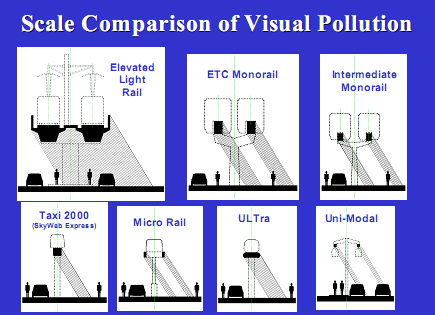Home
Benefits
Perspectives
Technology
FAQ
Pictures and Media
SkyTran is extraordinarily environment-friendly. Lightweight, streamlined SkyTran vehicles use about 1/10th the energy of a typical car -- over 200 MPG (85 KPL) equivalent at 100 MPH (161 KPH). It's "MPG equivalent" because SkyTran vehicles don't need gasoline or diesel at all, just electricity from the grid. SkyTran will let us jump directly to "smart-grid" renewable-energy transportation using today's technology -- no breakthroughs in battery and fuel cell research needed. The SkyTran development company Unimodal is already exploring partnerships with renewable energy companies to make SkyTran travel "double-zero" carbon-neutral (no fossil fuel usage + no net grid electricity). Because SkyTran is very efficient and also quick and low-impact to construct (see below), we think it has the best potential of any transportation proposal to cut oil consumption and carbon emissions in the near future.
Another kind of environmental impact is the physical footprint of the system, and SkyTran's is tiny. Literally. It's just a standard steel utility pole (the kind that hold up traffic signals and street lights) every 30 feet. The guideway tracks they support are just 1' (30 cm) wide -- far less than an elevated roadway or railway line. SkyTran vehicles will also be nearly silent even at 100 MPH, because they are small, streamlined, and ride on maglev rather than wheels or tires. Even when vehicles descend from the main guideway to drop off and pick up passengers, they will stop at stations above the street or attached to the sides of buildings (see footprint comparison below).

A minimal physical footprint also means that building a SkyTran system is far quicker and less traumatic and uses much less energy than building a new freeway or mass transit line. Compared with the air pollution and accident risk of ordinary roads or light rail, or the massive disruption of freeway construction, SkyTran brings convenient transportation at minimum environmental cost.
A less obvious green advantage: because SkyTran solves the problem of urban congestion better than any other current transport proposal, it may result in more people living in and near dense cities, which have far lower environmental impact than car-based suburban living. This is not a given, because convenient 100-MPH or 150-MPH travel will also make it easy to live even farther away from your job. However, we think the boost to the livability and productivity of cities will be more significant.
Clearly, building SkyTran systems will reduce fossil fuel consumption faster and with far less cost than even the most efficient cars and mass transit systems. Reducing the oil consumption and CO2 emissions of transportation is probably the most difficult part of energy efficiency -- weatherizing drafty houses and replacing inefficient heating systems is much less technically challenging.
Skytran vehicles are so efficient that it is possible to power them via solar cells on the guideway reducing the need for power plants and transmission lines. It may not be economically optimal to install solar cells for Skytran in the near term or in unsunny climates, none the less, high efficiency helps no matter what the ultimate source of power is.
Another kind of environmental impact is the physical footprint of the system, and SkyTran's is tiny. Literally. It's just a standard steel utility pole (the kind that hold up traffic signals and street lights) every 30 feet. The guideway tracks they support are just 1' (30 cm) wide -- far less than an elevated roadway or railway line. SkyTran vehicles will also be nearly silent even at 100 MPH, because they are small, streamlined, and ride on maglev rather than wheels or tires. Even when vehicles descend from the main guideway to drop off and pick up passengers, they will stop at stations above the street or attached to the sides of buildings (see footprint comparison below).

A minimal physical footprint also means that building a SkyTran system is far quicker and less traumatic and uses much less energy than building a new freeway or mass transit line. Compared with the air pollution and accident risk of ordinary roads or light rail, or the massive disruption of freeway construction, SkyTran brings convenient transportation at minimum environmental cost.
A less obvious green advantage: because SkyTran solves the problem of urban congestion better than any other current transport proposal, it may result in more people living in and near dense cities, which have far lower environmental impact than car-based suburban living. This is not a given, because convenient 100-MPH or 150-MPH travel will also make it easy to live even farther away from your job. However, we think the boost to the livability and productivity of cities will be more significant.
Clearly, building SkyTran systems will reduce fossil fuel consumption faster and with far less cost than even the most efficient cars and mass transit systems. Reducing the oil consumption and CO2 emissions of transportation is probably the most difficult part of energy efficiency -- weatherizing drafty houses and replacing inefficient heating systems is much less technically challenging.
Skytran vehicles are so efficient that it is possible to power them via solar cells on the guideway reducing the need for power plants and transmission lines. It may not be economically optimal to install solar cells for Skytran in the near term or in unsunny climates, none the less, high efficiency helps no matter what the ultimate source of power is.
